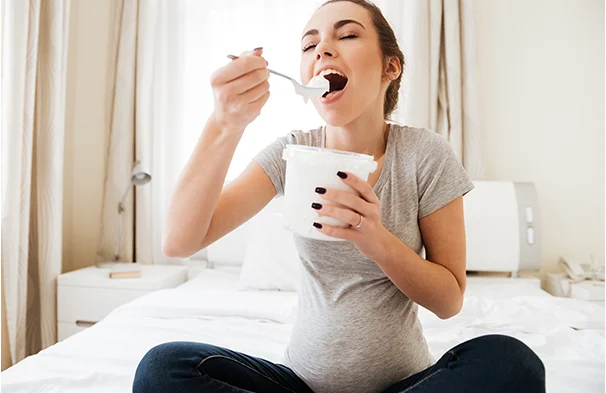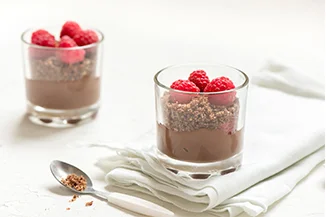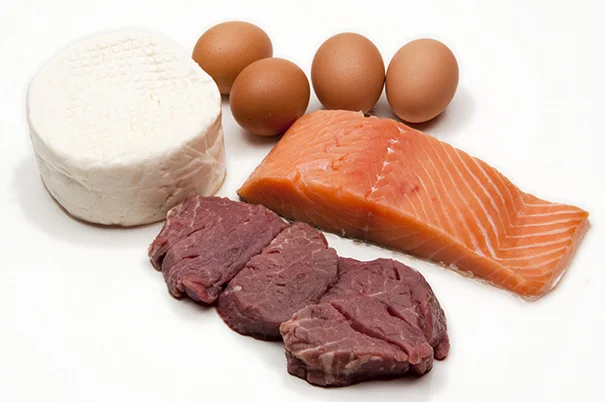

Pregnancy and food cravings are commonly described hand in hand, as they are frequently associated with one another. Many women will experience food cravings at some point during their pregnancies. Here we touch on pregnancy cravings to shed light on the topic.
1. What are pregnancy cravings?
Pregnancy cravings are the intense desire to consume specific types of food during pregnancy. These cravings are commonly reported in women of different backgrounds. Its prevalence is indicated anywhere within the range of 40-85% of pregnant women.1,2 Pregnancy cravings are normal and does not indicate problems in a pregnancy. Common types of foods craved by expectant mothers include sweets, fruits, dairy, salty snacks, sour/pickled foods and savoury foods.1,3 Although food cravings are frequently linked to pregnancy, it is also perfectly normal to not experience any cravings during pregnancy. The absence of food cravings (especially for fatty or sweet foods) may also mean that pregnant mothers are more likely to have a balanced and healthy diet.4
2. What causes pregnancy cravings?
Your pregnancy cravings may be caused by the hormonal changes during pregnancy. This in turn may contribute to change in sensitivity to tastes and smells, leading to preferences towards certain foods.1,3
Pregnancy cravings may also be a natural mechanism to accommodate the increased requirement of energy and other nutrients during pregnancy. These cravings ensure that you consume adequate nutrition for healthy foetal development.3
Further possible explanation to the causes of your pregnancy cravings is to encourage the intake of pharmacologically active substances present in certain foods, which might help to alleviate symptoms such as nausea and vomiting during pregnancy.3
3. When do pregnancy cravings start and how long does it last?
The nature of food cravings and its intensity during pregnancy is unique from person to person.1 Generally, food cravings may arise by the end of the first trimester. The frequency and intensity of these cravings may reach a high point during the second trimester. Many women experienced reduced cravings towards the end of their pregnancies.3,5
4. Is it okay to give in to pregnancy cravings?
While the occasional indulgence may not be harmful, you must pay attention to the cravings and indulge within reason.6 You should exercise caution when consuming less-than-healthy foods and search for healthier alternatives to satisfy your food cravings.7 For example, you could substitute ice cream with frozen yogurt, or fried chicken with baked chicken.7

Substitute ice cream with frozen yoghurt
If you have gestational diabetes (GDM), you should not consume too much sweet foods. Using smaller plates or bowls encourages portion control; the limited capacity would help you take smaller servings so you would not overeat.
Some types of foods pose certain risks when eaten in large amounts. Consuming a lot of anchovies, for example, may inadvertently lead to excessive salt intake, which aggravates swelling in pregnant mothers.8,9 You should make sure your sodium intake does not exceed 2300 mg/day and drink plenty of water.8

Substitute ice cream with frozen yoghurt
Expectant mothers should not let their cravings dictate their daily diet. You must maintain a healthy balanced diet with adequate intake of nutrients and energy.6 Prenatal supplements are a good way to keep these nutritional requirements in check.

Use smaller plates/bowls to encourage portion control
Giving in to cravings for foods high in fat or sugar can lead to excessive weight gain, GDM, or other problems that can last beyond the pregnancy. It is helpful to determine whether it is safe to indulge in your food cravings by categorising them into different groups: green light foods for healthy foods (e.g fruits and vegetables), yellow light foods for foods which are good in small amounts but bad in large amounts (e.g. chocolate and salted nuts) and red light foods for unhealthy/harmful foods (e.g. foods with excess refined sugar).10

Use smaller plates/bowls to encourage portion control
5. Should I be worried about weird pregnancy cravings?
‘Pica’ is the persistent craving for substances with no nutritional value, such as earthy items (e.g. soil, clay and chalk), raw starches (e.g. corn starch and uncooked rice) and ice.11 It afflicts many pregnant women around the world.11 Although the causes are not fully clear, pica is suggested to be a symptom for mineral deficiency as well as a way to cope with emotional stress, among others.3,12
If you engage in pica, you potentially run the risk of problems such as micronutrient imbalance, heavy metal poisoning and gastrointestinal tract damage.11 Pregnant mothers are advised to not indulge in non-food cravings and consult a doctor if any such craving arises.
Alcohol cravings have also been reported among pregnant women.1 Alcohol cravings are dangerous to give in to, as it contributes to development of fetal alcohol syndrome disorders (FASDs) such as learning disabilities, hyperactivity and growth problems.13,14 FASDs are completely preventable by abstaining from alcohol during pregnancy.13
Raw / undercooked meats and eggs, and soft cheeses should be consumed with caution on general, and especially avoided during pregnancy. These foods are likely to carry a high level of bacteria such as salmonella and listeria. Consuming these foods increases risk of infection, which may be harmful for both mother and baby.14 If you crave these types of foods, be sure to opt for safer options such as well-cooked meats, pasteurised eggs and cheese made from pasteurised milk.14


Avoid raw/undercooked meats and eggs, and soft cheeses
Manage your unhealthy food cravings with these tips15:
• Make sure to take regular, balanced meals to prevent sudden feelings of hunger
• Find healthier alternatives to substitute unhealthy food cravings.
• Pick some healthy snacks (such as dark chocolate) to savour throughout the day.
• Don’t buy food when hungry.
• Eating low glycaemic index (GI) foods keeps you full until the next mealtime.
• Don’t skimp on good sleep. Sleep deprivation increases one’s tendency to crave for high-calorie foods.16
• If you find your cravings are constant, then sometimes a little meditative therapy can help. Practicing yoga, going for a walk, or spending time doing enjoyable things with friends will help take your mind off your cravings.
Article contributed by Dato’ Dr Siti Zaliha, Consultant Obstetrician & Gynaecologist
DISCLAIMER: THIS WEBSITE DOES NOT PROVIDE MEDICAL ADVICE
The information, including but not limited to, text, graphics, images and other material contained on this website are for informational purposes only shall not be construed as medical advice or instruction. It is not intended to be a substitute for professional medical advice, diagnosis or treatment. Always seek the advice of your physician or other qualified health care provider with any questions you may have regarding a medical condition or treatment and before undertaking a new health care regimen, and never disregard professional medical advice or delay in seeking it because of something you have read on this website. No action or inaction should be taken based solely on the contents of this information; instead, readers should consult appropriate health professionals on any matter relating to their health and well-being. The information and opinions expressed here are believed to be accurate, based on the best judgement available to the authors, and readers who fail to consult with appropriate health authorities assume the risk of any injuries. In addition, the information and opinions expressed here do not necessarily reflect the views of Mead Johnson Nutrition (M) Sdn Bhd and its Affiliates. Mead Johnson Nutrition (M) Sdn Bhd and its Affiliates are not responsible for errors or omissions. Mead Johnson Nutrition (M) Sdn Bhd and its Affiliates do not recommend or endorse any specific tests, physicians, products, procedures, opinions or other information that may be mentioned on this website. Reliance on any information appearing on this website is solely at your own risk.
REFERENCES:
1) Hill AJ, Cairnduff V, McCance DR. Nutritional and clinical associations of food cravings in pregnancy. J Hum Nutr Diet. 2016;29(3):281-9.
2) Walker AR, Walker BF, Jones J, Verardi M, Walker C. Nausea and vomiting and dietary cravings and aversions during pregnancy in South African women. BJOG. 1985;92(5):484-9.
3) Orloff NC, Hormes JM. Pickles and ice cream! Food cravings in pregnancy: hypotheses, preliminary evidence, and directions for future research. Front Psychol. 2014;5:1076.
4) Baby Center. Is it normal not to have food cravings during pregnancy?. Available at https://www.babycentre.co.uk/x1049139/is-it-normal-not-to-have-food-crav.... Accessed on 13 September 2018.
5) Belzer LM, Smulian JC, Lu SE, Tepper BJ. Food cravings and intake of sweet foods in healthy pregnancy and mild gestational diabetes mellitus. A prospective study. Appetite 2010;55(3):609-15.
6) National Institutes of Health. Eating right during pregnancy. Available at https://medlineplus.gov/ency/patientinstructions/000584.htm. Accessed on 23 August 2018.
7) Baby Center. Six healthy fixes for pregnancy junk food cravings. Available at https://www.babycenter.com/0_six-healthy-fixes-for-pregnancy-junk-food-c.... Accessed on 23 August 2018.
8) Baby Center. 12 worst foods for pregnancy. Available at https://www.babycenter.com/0_12-worst-foods-for-pregnancy_10395224.bc. Accessed on 26 October 2018.
9) Action on Salt. How to eat less salt. Available at http://www.actiononsalt.org.uk/less/reducing-intake/. Accessed on 27 August 2018.
10) Mom Loves Best. Pregnancy cravings and hints to conquer them. Available at. https://momlovesbest.com/pregnancy-cravings. Accessed on 13 September 2018.
11) Young SL. Pica in pregnancy: new ideas about an old condition. Annu Rev Nutr. 2010;30:403-22.
12) Roy A, Fuentes-Afflick E, Fernald LC, Young SL. Pica is prevalent and strongly associated with iron deficiency among Hispanic pregnant women living in the United States. Appetite 2018;120:163-70.
13) Ministry of Health Malaysia. Perinatal care manual, third edition. Available at http://fh.moh.gov.my/v3/index.php/component/jdownloads/send/18-sektor-ke.... Accessed on 27 August 2018.
14) American Pregnancy Association. Foods to avoid during pregnancy. Available at http://americanpregnancy.org/pregnancy-health/foods-to-avoid-during-preg.... Accessed on 14 September 2018.
15) Pregnancy, Birth and Baby. Food cravings during pregnancy. Available at https://www.pregnancybirthbaby.org.au/food-cravings-during-pregnancy. Accessed on 14 Septermber 2018.
16) Greer SM, Goldstein AN, Walker MP. The impact of sleep deprivation on food desire in the human brain. Nat Commun. 2013;4:2259.
MYS-01/08P28/18238





